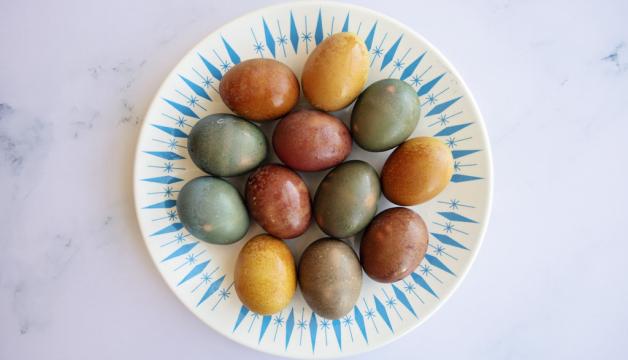


Sign-up for {N}power to get exclusive discounts, newsletters, members-only features, and more!
 Denver - Design District - Alameda and Broadway
Denver - Design District - Alameda and Broadway
368 S Broadway
Denver, CO 80209
United States
 Preferred Store:
Select a Store
Preferred Store:
Select a Store


Making your own egg dye from natural foods is simple and fun. You can even use brown-shelled eggs—with their darker base, they enhance the color, creating a range of earthy jewel tones. Just mix up your dyes and let the eggs soak until your desired color is reached. The dye can be used to make more eggs, just be sure to keep it in the refrigerator. And remember that natural dyes stain too, so be sure to protect your egg dyeing area and clothes!
1. Make the dye: Add four cups of water to three separate saucepans; add the beets to one saucepan, the cabbage to another, and the turmeric to the third. Bring the mixtures to a boil, partially cover the pans, and reduce heat to a simmer. Simmer for 30 minutes. Note: Gently stir the turmeric mixture as it comes to a boil to prevent foam from boiling over.
2. Strain the beets and cabbage, one at a time, through a fine mesh strainer into their own glass jars or bowls. Allow the turmeric pan to rest off heat for several minutes for the powder to settle to the bottom of the pan. Slowly pour off the water into its own glass jar or bowl, leaving as much of the wet powder in the pan as possible (but don’t worry if some of the turmeric powder makes it into the dye mixture).
3. Transfer dyes to the refrigerator and allow them to cool for at least two hours.
4. Once the dyes are cool, mix two tablespoons of vinegar into each color. Then make additional colors as desired in separate jars or bowls by combining:
5. If desired, add designs by drawing on the eggs with crayons, wrapping them with tightly fitted rubber bands, or cutting designs out of tape and securely adhering them to the eggs.
6. Dye the eggs: Gently add the eggs to prepared dyes using a slotted spoon. You can add several eggs to each dye at once, just make sure the eggs are completely submerged. Allow eggs to remain in the dye for two hours, up to 24 hours (in the refrigerator), check the color occasionally. The longer they stay in the dye, the darker the final color will be. Gently remove the eggs from the dye with a slotted spoon once your desired color is reached.
7. Allow dyed eggs to air dry completely in an empty egg carton. If you used rubber bands or tape, allow eggs to dry completely before removing. Be sure to store your dyed eggs in the refrigerator until you are ready to eat them.
Get ready to celebrate Easter with our delicious assortment of recipes!
Browse Easter Recipes
We've got ideas to help you plan your next meal ... or five!
See more meal ideas


Sign-up for {N}power to get exclusive discounts, newsletters, members-only features, and more!
